Friday, 15 June, Panic and Picasso
Written 1 July 2018
Next on our list of things to see was the Delacroix retrospective at the Louvre. I suspected the lines would be long and that we should have lined up tickets before we left Tallahassee, but we decided to go ahead anyway. If we couldn't get in, we could just walk a few blocks to the actual Delacroix museum and look at that instead.
I slept late, then went out for breakfast bread and pastry. My usual purchase was a half baguette and a pain au chocolat. I would eat half of the half baguette, and the other half could be reheated the next day. After the first couple of days, I never went back to the chain bakery, but alternated among Poilâne, the Rond des Pains, and Manon, all within a block of each other. Poilâne made the best pain au chocolat, but they don't do baguettes, being famous for large, round, whole grain breads (which are delicious but not what I look for in a Paris breakfast). Rond des Pains made better baguettes, but Manon would do when the others were closed. Nobody in the neighborhood made baguettes to rival the fabulous flûtes Ganachaud we used to get in the 20th arrondissement, but I wasn't willing to take a long metro ride just to buy breakfast.
David got up a little earlier than usual, so we left at 11:30 a.m., headed for the Louvre. At Bastille, where we were to change from the #8 metro to the #1, I boarded the #1 train just before the warning buzzer, but David got cut off by a passer-by and the doors slammed before he could get in! Through the glass door, I mouthed "I'll wait at the next station," but I wasn't sure whether he understood. As the train hurtled down the line, I tried to think of the best strategy for getting us back together—David had no phone and didn't know the number of mine, and I had our book of maps with me, but he knew we were headed for the Palais Royal stop, and he knew the way back to the apartment, but didn't have a key.
Okay, Hypothesis 1: He understood what I said through the door. I accordingly got off at St. Paul, stood at the same spot on the platform, and waited for the next train. After pausing and sighting down the platform to make sure he didn't get off it, I got on it and looked for him. Not there! It was one of the newer trains, open from end to end, and the line is straight. It wasn't crowded, so I could see all the way down, and his Tilley hat was nowhere in sight. Drat.
Hypothesis 2: He didn't understand what I said, and he was going by my family's default strategy—the one who gets lost stays put and waits for the others to retrace their steps until they find him. I accordingly got off at the next stop (Hôtel de Ville), changed platforms, and headed back two stops to Bastille. We wasn't there. Drat again.
Hypothesis 3: He was going by our usual airport default—if you get separated, meet at the departure gate. In this case, I thought that would be the platform at Palais Royal, so I changed platforms again and headed for Palais Royal. I really expected to find him on the platform when I got off, but he wasn't there. Drat, drat, drat. Now what?
Hypothesis 4: He gave up and went back to the apartment, figuring I had to come back there eventually. As it happens, our rental agent had said she planned to drop by the apartment at lunch time to deal with phone messages left for the proprietor, so I called her and left a message explaining the situation, giving my phone number, and asking her, if she found David there, to let him in and have him call me from the apartment phone.
At this point, I was basically at the Louvre (you can walk straight from the Palais Royal metro station into the basement of the Louvre), so I decided to go ahead over there and try for a reservation for Delacroix for another day before heading back to the apartment. When I did, I was astonished to find no line at all! I breezed through the security checkpoint between the basement of the Carousel du Louvre shopping mall and the basement of the Louvre itself. It consisted of a little wooden table manned by a single inspector, who looked into every handbag, while an armed colleague stood by keeping an eye on things. (Strangely, although every Paris museum now makes you open your handbag for cursory inspection, not one inspector showed the slightest interest in the full 20-oz water bottle hanging by a carabiner from my purse strap. I guess acid attacks have gone out of style.) I then continued down the hallway until I was under the pyramid itself, and looked around for ticket sales. I was delighted to find that the new ticket counter consisted of a large room entirely lined with tellers' windows and automated kiosks, each with perhaps two parties lined up waiting! Whoa, I thought, this is great! They've solved that awful bottleneck that created such long lines!
Not sure whether I could reserve for future dates at the kiosks, I stepped into the next room, where a couple of group-sales clerks were actually doing nothing at all and asked whether one of them could help me. Not a problem, she said—the next opening for the Delacroix was Monday at 11:30 a.m., which suited me fine. I paid for the tickets, and she warned me that, in addition to these tickets for the special exhibition, we would need to buy general admission tickets to the Louvre on the day, so be sure to allow time for that.
Delacroix tickets in hand, I took the metro back to the apartment, where I found David waiting in the courtyard and starving—he'd had no breakfast, and it was almost 2 p.m. So we headed down to the Progres for omelets. He had understood me, but had missed the next train and taken the one after. Not finding me at the next stop, he had taken the train after that to Palais Royal while I was heading back to Bastille. He waited at Palais Royal but must have given up and headed home just before I got there. He hadn't seen the rental agent. I texted her that we had finally found each other.

 The ham, cheese, and potato omelets were good. You can tell the kitchen's serious when they ask how you want your omelet cooked, just as they would for a steak: "bien cuit" (well done) or "baveuse" (runny)? I countered with "cremeuse?" (creamy?) and got just what I wanted.
The ham, cheese, and potato omelets were good. You can tell the kitchen's serious when they ask how you want your omelet cooked, just as they would for a steak: "bien cuit" (well done) or "baveuse" (runny)? I countered with "cremeuse?" (creamy?) and got just what I wanted.
Having lost so much time in the Great Metro Mix-up, we decided to do something close by in the afternoon—the newly refurbished Picasso Museum, which was only a few blocks away and, we discovered, happened to be doing a major exhibition on Picasso's Guernica.
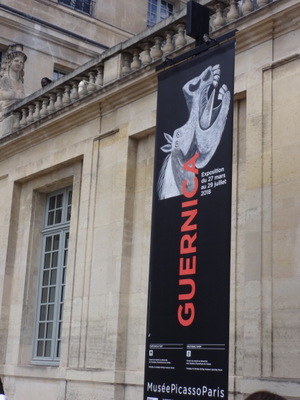
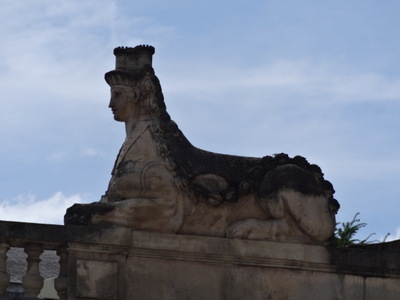 The museum is in an old house, the one where Picasso lived, I think. The banner advertising the exhibition features a study that Picasso did for the horse's head in Guernica, and on the parapet surrounding the building's courtyard this Egyptian motif dates the building (or at least a renovation of it) to the craze for Egyptiana that followed Napoleon's Egyptian campaign, around the turn of the 19th century.
The museum is in an old house, the one where Picasso lived, I think. The banner advertising the exhibition features a study that Picasso did for the horse's head in Guernica, and on the parapet surrounding the building's courtyard this Egyptian motif dates the building (or at least a renovation of it) to the craze for Egyptiana that followed Napoleon's Egyptian campaign, around the turn of the 19th century.
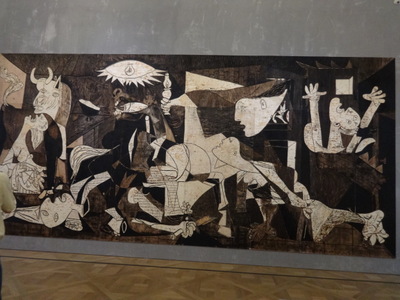
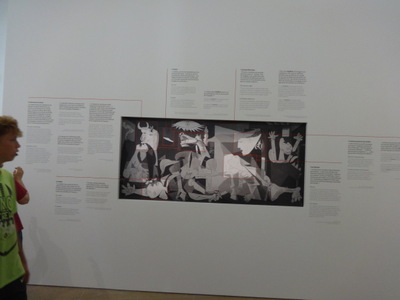 The original of Guernica is too fragile to be moved, so it no longer travels. In the exhibition, this full-size replica of it stood in for the actual painting.
The original of Guernica is too fragile to be moved, so it no longer travels. In the exhibition, this full-size replica of it stood in for the actual painting.
At the right is a large diagram explaining features of the work. Highlighted features of the painting are linked to detailed explanations of their signficance, symbolism, and origins. You can see that the horse's head in the finished work (just below the electric light bulb at the top is very different from the study used on the banner (and displayed nearby). I found this display particularly helpful and took a number of closer photos of the explanations. If you'd like to see them, let me know.
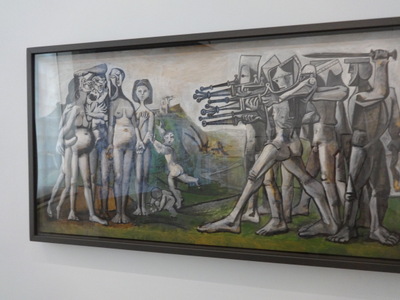
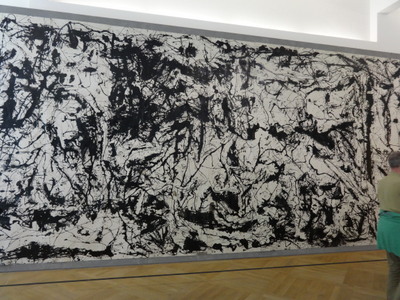 The exhibition also included other war-themed works by Picasso, like this Massacre in Korea, in which soldiers armed with everthing from swords to ray-guns prepare to attack women and children, and works by others that were inspired by Guernica. The more I looked at it, the more I liked this "Guernica in the style of Jackson Pollock" (no individual artist named). The image is actually in there!
The exhibition also included other war-themed works by Picasso, like this Massacre in Korea, in which soldiers armed with everthing from swords to ray-guns prepare to attack women and children, and works by others that were inspired by Guernica. The more I looked at it, the more I liked this "Guernica in the style of Jackson Pollock" (no individual artist named). The image is actually in there!
Written 4 July 2018
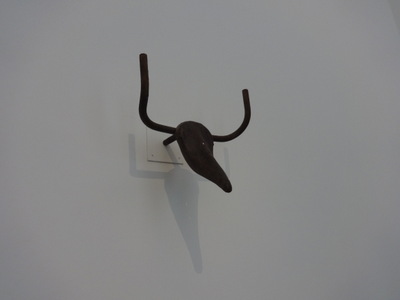
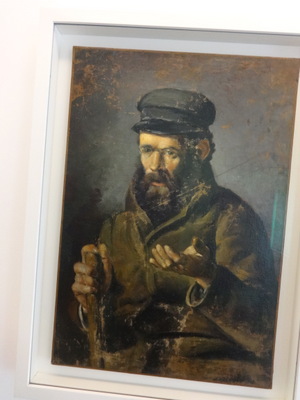 I've always this bull's head made from bicycle parts, but the portrait at the right (Man with a Cap) was new to me. Picasso painted it when he was just 13 years old and kept it in his studio (wherever that was at the time) all his life. I always knew I tended to find his earlier work more accessible than the later stuff—clearly I need to see what he was doing as a toddler!
I've always this bull's head made from bicycle parts, but the portrait at the right (Man with a Cap) was new to me. Picasso painted it when he was just 13 years old and kept it in his studio (wherever that was at the time) all his life. I always knew I tended to find his earlier work more accessible than the later stuff—clearly I need to see what he was doing as a toddler!

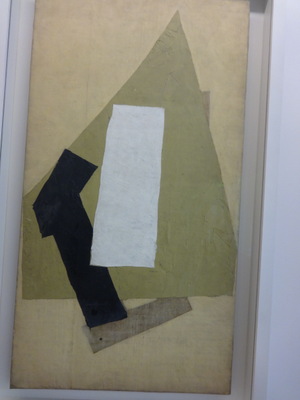 I think I understand, at least on an intellectual if not an artistic level, what many of his cubist works are trying to do. I can clearly see the "Large Bather with a Book" in the painting at the left. I can even see the book, though it appears to be to be face down. I can see the human figure in Duchamp's "Nude Descending a Staircase" and the objects in most of Picasso's still lives with guitar, but I have to confess—I cannot see the guitar in the image at the right, entitled "Guitar." It doesn't even look like the pile of materials that someone intends to make into a guitar. Any of you art lovers out there have any insights to offer? I know I'm pretty artistically obtuse, but I'm trying . . .
I think I understand, at least on an intellectual if not an artistic level, what many of his cubist works are trying to do. I can clearly see the "Large Bather with a Book" in the painting at the left. I can even see the book, though it appears to be to be face down. I can see the human figure in Duchamp's "Nude Descending a Staircase" and the objects in most of Picasso's still lives with guitar, but I have to confess—I cannot see the guitar in the image at the right, entitled "Guitar." It doesn't even look like the pile of materials that someone intends to make into a guitar. Any of you art lovers out there have any insights to offer? I know I'm pretty artistically obtuse, but I'm trying . . .
One work I absolutely loved but didn't get a very good photo of was Le Peintre et l'Enfant (The Painter and the Child). It's cubist (I guess), almost cartoonish, and it portrays a small child brandishing a paintbrush and the artist just behind and to the right of him. Despite the wonkily placed eyes and square heads, it manages to convey a dawning look of glee on the child's face and on the artist's a dawning look of "Oh, no, maybe this wasn't such a good idea; what have I done?!" Fabulous! You can easily Google up an image of it.
On emerging from the museum and wending our way through a couple of tiny streets back to the Rue de Turenne, up which we planned to walk home, we found ourselves just across the street from the St, Claude bus stop, and I could see the #96 bus approaching, so we cross over, hopped on, and rode one stop up the hill to our place. Love those transit passes.
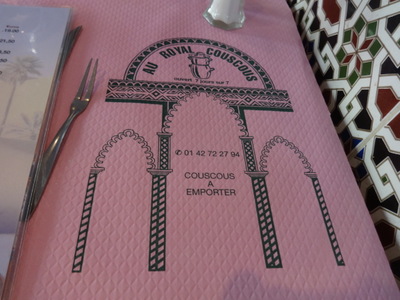
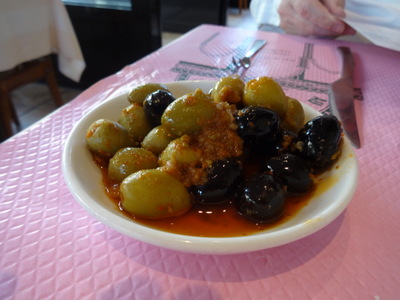 We had chosen this evening for our couscous dinner. We had three choices: the couscous counter in the Marché des Enfants Rouges; Chez Omar, a few blocks along; and Au Royal Couscous, near the Place de la République. I had scoped them all out and settled on the last, as the only one with "brik à l'oeuf" on its menu. I've read about egg brik's for years, and we've had a couple of really great ones over the years, but not every couscous place makes them.
We had chosen this evening for our couscous dinner. We had three choices: the couscous counter in the Marché des Enfants Rouges; Chez Omar, a few blocks along; and Au Royal Couscous, near the Place de la République. I had scoped them all out and settled on the last, as the only one with "brik à l'oeuf" on its menu. I've read about egg brik's for years, and we've had a couple of really great ones over the years, but not every couscous place makes them.
While we studied the menu, they brought us this dish of marinated olives, which look positively fierce, covered with crushed chilis and whatnot. For my initial taste, I was careful to wipe most of the marinade off, but surprisingly, they turned out to be quite mild, even with the marinade on them.
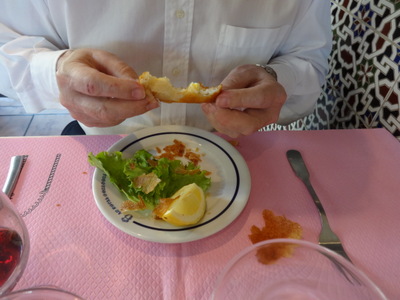
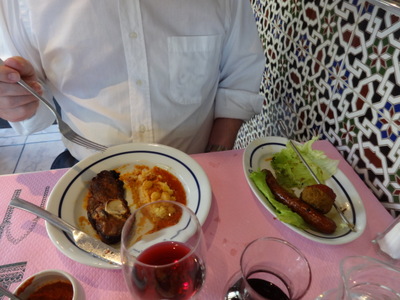 At the left, Davis is finishing off his brik, which consists of a very thin sheet of pastry (called warka or feuille de brik; must more flexible than phyllo) wrapped around seasonings and a raw egg and deep fried until very crispy and the egg is cooked about over medium. Served with a lemon wedge. As you can imagine, they are tricky to make; wrapping a loose raw egg in a sheet of fragile pastry is not easy (I've tried)! Like the olives, these were very mild, even underseasoned, but they were appropriately crispy and tasty, and the egg was cooked just right.
At the left, Davis is finishing off his brik, which consists of a very thin sheet of pastry (called warka or feuille de brik; must more flexible than phyllo) wrapped around seasonings and a raw egg and deep fried until very crispy and the egg is cooked about over medium. Served with a lemon wedge. As you can imagine, they are tricky to make; wrapping a loose raw egg in a sheet of fragile pastry is not easy (I've tried)! Like the olives, these were very mild, even underseasoned, but they were appropriately crispy and tasty, and the egg was cooked just right.
[NOTE: Since coming home, I've had reasonable luck using ordinary French-style crêpes for the wrapping. Still working on it.]
At the left is David's plate. He ordered the "couscous royal," which consisted of a platter of meat (keftah meatballs, lamb chops, skewer of lamb chunks, merguez sausage), accompanied by couscous and a large bowl of vegetables and sauce.
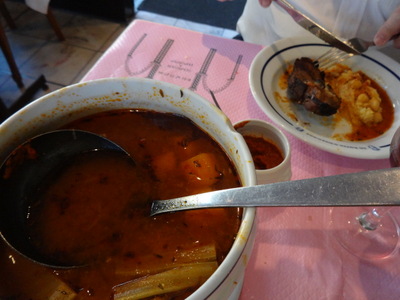
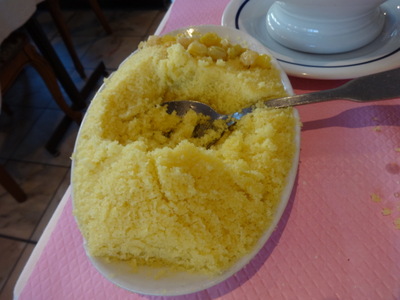 Here's the large bowl of vegetables and sauce. Parisian restaurants almost always serve this style of couscous, in which the sauce is a thin as soup and the vegetables, cut into large chunks, float in it. I assume that style comes from Algeria. (At home, I cook out of a Moroccan cookbook, so my sauce is thick, and the vegetables are served on the platter with the meat.) This one contained celery, zucchini, carrots, potatoes, and chick peas. Behind it, you can see the little pot of red harissa sauce, traditionally extremely spicy.
Here's the large bowl of vegetables and sauce. Parisian restaurants almost always serve this style of couscous, in which the sauce is a thin as soup and the vegetables, cut into large chunks, float in it. I assume that style comes from Algeria. (At home, I cook out of a Moroccan cookbook, so my sauce is thick, and the vegetables are served on the platter with the meat.) This one contained celery, zucchini, carrots, potatoes, and chick peas. Behind it, you can see the little pot of red harissa sauce, traditionally extremely spicy.
At the right is the platter of couscous grains. I say "grains," because of their fluffy, crumbly texture, but they are not in fact grain but teeny-tiny bits of (wheat) pasta. At the far end of the platter are stewed golden raisins for those who want them.

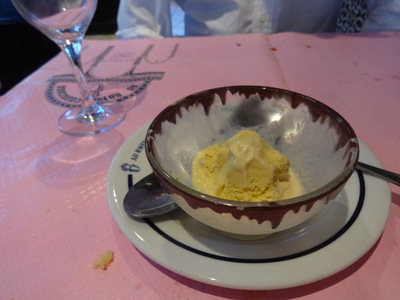 I ordered a tagine of lamb with prunes and raisins (the other option was with lemons and olives). Clockwise from the top are a couple of tender stewed prunes, large chunks of tomato partially covering large chunks of potato, chunks of tender and succulent braised lamb shoulder (around the edge of the white plate, you can see the big bones I had already extracted from the chunks of lamb), and the pile of couscous I spooned on from the platter. Over, under, around, and through all that were pieces of stewed onion, raisins, and almonds. No chick peas; I had to fish those out of the soup pot.
I ordered a tagine of lamb with prunes and raisins (the other option was with lemons and olives). Clockwise from the top are a couple of tender stewed prunes, large chunks of tomato partially covering large chunks of potato, chunks of tender and succulent braised lamb shoulder (around the edge of the white plate, you can see the big bones I had already extracted from the chunks of lamb), and the pile of couscous I spooned on from the platter. Over, under, around, and through all that were pieces of stewed onion, raisins, and almonds. No chick peas; I had to fish those out of the soup pot.
Again, the watchword of the dinner was "mild." Underseasoned (not just not hot-spicy but not even flavorful-spicy). The traditional way to add extra spice to couscous is to dip up a ladel-ful of the soup, stir a spoonful of harissa into it, and pour the mixture over your food. Even the harissa was so mild that I gave up on that method and applied a bunch of it directly. Alas, we never found a way to fit in another couscous dinner, so I don't know whether the other places season in the same way.
At the right is the caramel ice cream with which I finished the meal.
Previous entry
List of Entries
Next entry

 The ham, cheese, and potato omelets were good. You can tell the kitchen's serious when they ask how you want your omelet cooked, just as they would for a steak: "bien cuit" (well done) or "baveuse" (runny)? I countered with "cremeuse?" (creamy?) and got just what I wanted.
The ham, cheese, and potato omelets were good. You can tell the kitchen's serious when they ask how you want your omelet cooked, just as they would for a steak: "bien cuit" (well done) or "baveuse" (runny)? I countered with "cremeuse?" (creamy?) and got just what I wanted. 
 The museum is in an old house, the one where Picasso lived, I think. The banner advertising the exhibition features a study that Picasso did for the horse's head in Guernica, and on the parapet surrounding the building's courtyard this Egyptian motif dates the building (or at least a renovation of it) to the craze for Egyptiana that followed Napoleon's Egyptian campaign, around the turn of the 19th century.
The museum is in an old house, the one where Picasso lived, I think. The banner advertising the exhibition features a study that Picasso did for the horse's head in Guernica, and on the parapet surrounding the building's courtyard this Egyptian motif dates the building (or at least a renovation of it) to the craze for Egyptiana that followed Napoleon's Egyptian campaign, around the turn of the 19th century.
 The original of Guernica is too fragile to be moved, so it no longer travels. In the exhibition, this full-size replica of it stood in for the actual painting.
The original of Guernica is too fragile to be moved, so it no longer travels. In the exhibition, this full-size replica of it stood in for the actual painting.
 The exhibition also included other war-themed works by Picasso, like this Massacre in Korea, in which soldiers armed with everthing from swords to ray-guns prepare to attack women and children, and works by others that were inspired by Guernica. The more I looked at it, the more I liked this "Guernica in the style of Jackson Pollock" (no individual artist named). The image is actually in there!
The exhibition also included other war-themed works by Picasso, like this Massacre in Korea, in which soldiers armed with everthing from swords to ray-guns prepare to attack women and children, and works by others that were inspired by Guernica. The more I looked at it, the more I liked this "Guernica in the style of Jackson Pollock" (no individual artist named). The image is actually in there!
 I've always this bull's head made from bicycle parts, but the portrait at the right (Man with a Cap) was new to me. Picasso painted it when he was just 13 years old and kept it in his studio (wherever that was at the time) all his life. I always knew I tended to find his earlier work more accessible than the later stuff—clearly I need to see what he was doing as a toddler!
I've always this bull's head made from bicycle parts, but the portrait at the right (Man with a Cap) was new to me. Picasso painted it when he was just 13 years old and kept it in his studio (wherever that was at the time) all his life. I always knew I tended to find his earlier work more accessible than the later stuff—clearly I need to see what he was doing as a toddler!
 I think I understand, at least on an intellectual if not an artistic level, what many of his cubist works are trying to do. I can clearly see the "Large Bather with a Book" in the painting at the left. I can even see the book, though it appears to be to be face down. I can see the human figure in Duchamp's "Nude Descending a Staircase" and the objects in most of Picasso's still lives with guitar, but I have to confess—I cannot see the guitar in the image at the right, entitled "Guitar." It doesn't even look like the pile of materials that someone intends to make into a guitar. Any of you art lovers out there have any insights to offer? I know I'm pretty artistically obtuse, but I'm trying . . .
I think I understand, at least on an intellectual if not an artistic level, what many of his cubist works are trying to do. I can clearly see the "Large Bather with a Book" in the painting at the left. I can even see the book, though it appears to be to be face down. I can see the human figure in Duchamp's "Nude Descending a Staircase" and the objects in most of Picasso's still lives with guitar, but I have to confess—I cannot see the guitar in the image at the right, entitled "Guitar." It doesn't even look like the pile of materials that someone intends to make into a guitar. Any of you art lovers out there have any insights to offer? I know I'm pretty artistically obtuse, but I'm trying . . .
 We had chosen this evening for our couscous dinner. We had three choices: the couscous counter in the Marché des Enfants Rouges; Chez Omar, a few blocks along; and Au Royal Couscous, near the Place de la République. I had scoped them all out and settled on the last, as the only one with "brik à l'oeuf" on its menu. I've read about egg brik's for years, and we've had a couple of really great ones over the years, but not every couscous place makes them.
We had chosen this evening for our couscous dinner. We had three choices: the couscous counter in the Marché des Enfants Rouges; Chez Omar, a few blocks along; and Au Royal Couscous, near the Place de la République. I had scoped them all out and settled on the last, as the only one with "brik à l'oeuf" on its menu. I've read about egg brik's for years, and we've had a couple of really great ones over the years, but not every couscous place makes them.
 At the left, Davis is finishing off his brik, which consists of a very thin sheet of pastry (called warka or feuille de brik; must more flexible than phyllo) wrapped around seasonings and a raw egg and deep fried until very crispy and the egg is cooked about over medium. Served with a lemon wedge. As you can imagine, they are tricky to make; wrapping a loose raw egg in a sheet of fragile pastry is not easy (I've tried)! Like the olives, these were very mild, even underseasoned, but they were appropriately crispy and tasty, and the egg was cooked just right.
At the left, Davis is finishing off his brik, which consists of a very thin sheet of pastry (called warka or feuille de brik; must more flexible than phyllo) wrapped around seasonings and a raw egg and deep fried until very crispy and the egg is cooked about over medium. Served with a lemon wedge. As you can imagine, they are tricky to make; wrapping a loose raw egg in a sheet of fragile pastry is not easy (I've tried)! Like the olives, these were very mild, even underseasoned, but they were appropriately crispy and tasty, and the egg was cooked just right.
 Here's the large bowl of vegetables and sauce. Parisian restaurants almost always serve this style of couscous, in which the sauce is a thin as soup and the vegetables, cut into large chunks, float in it. I assume that style comes from Algeria. (At home, I cook out of a Moroccan cookbook, so my sauce is thick, and the vegetables are served on the platter with the meat.) This one contained celery, zucchini, carrots, potatoes, and chick peas. Behind it, you can see the little pot of red harissa sauce, traditionally extremely spicy.
Here's the large bowl of vegetables and sauce. Parisian restaurants almost always serve this style of couscous, in which the sauce is a thin as soup and the vegetables, cut into large chunks, float in it. I assume that style comes from Algeria. (At home, I cook out of a Moroccan cookbook, so my sauce is thick, and the vegetables are served on the platter with the meat.) This one contained celery, zucchini, carrots, potatoes, and chick peas. Behind it, you can see the little pot of red harissa sauce, traditionally extremely spicy.
 I ordered a tagine of lamb with prunes and raisins (the other option was with lemons and olives). Clockwise from the top are a couple of tender stewed prunes, large chunks of tomato partially covering large chunks of potato, chunks of tender and succulent braised lamb shoulder (around the edge of the white plate, you can see the big bones I had already extracted from the chunks of lamb), and the pile of couscous I spooned on from the platter. Over, under, around, and through all that were pieces of stewed onion, raisins, and almonds. No chick peas; I had to fish those out of the soup pot.
I ordered a tagine of lamb with prunes and raisins (the other option was with lemons and olives). Clockwise from the top are a couple of tender stewed prunes, large chunks of tomato partially covering large chunks of potato, chunks of tender and succulent braised lamb shoulder (around the edge of the white plate, you can see the big bones I had already extracted from the chunks of lamb), and the pile of couscous I spooned on from the platter. Over, under, around, and through all that were pieces of stewed onion, raisins, and almonds. No chick peas; I had to fish those out of the soup pot.